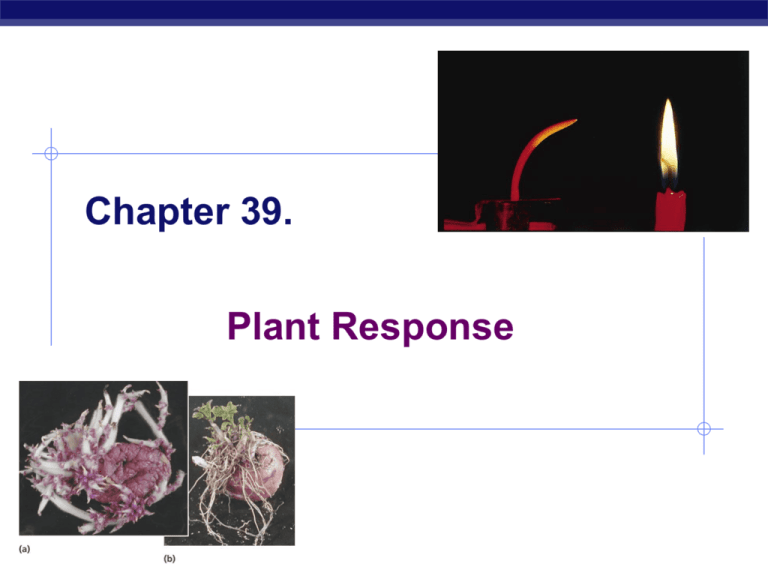AP & Regents Biology - Revere Local Schools
advertisement

Chapter 39. Plant Response AP Biology Plant Reactions Stimuli & a Stationary Life animals respond to stimuli by changing behavior move toward positive stimuli move away from negative stimuli AP Biology plants respond to stimuli by adjusting growth & development What mechanism causes this response? grown in dark AP Biology 1 week exposure to light Signal Transduction Pathway model signal triggers receptor receptor triggers internal cellular messengers & then cellular response receptor signal pathway (2° messengers) response What kinds of molecules are theBiology receptors? AP Signal Transduction Pathway example 1. Light signal is detected by the phytochrome receptor, which then activates least 2 uses cGMP as a 2nd 2. Oneatpathway signal transduction pathways messenger to activate 3. Both pathways leada protein kinase. to expression of genes The pathway forother proteins that involves increases Ca2+ that function in in cytoplasmic greening activates a different response of plant. protein kinase. AP Biology Plant hormones Chemical signals that coordinate different parts of an organism only minute amounts are required produced by 1 part of body transported to another part binds to specific receptor triggers response in target cells & tissues AP Biology Plant hormones auxins cytokinins gibberellins brassinosteroids abscisic acid ethylene AP Biology Phototropism Growth towards light Went 1926 AP Biology Auxin Indolacetic acid (IAA) stimulates cell elongation near apical meristems enhances apical dominance classical explanation of phototropism asymmetrical distribution of auxin cells on darker side elongate faster than cells on brighter side AP Biology Zones of meristem growth shoot AP Biology root Polarity of auxin transport 1. Auxin picks up H+ between cells & is neutralized 2. Neutral auxin passes through membrane 3. Cellular pH 7 causes auxin to ionize & is trapped in cell 4. Auxin stimulates proton pump 5. Auxin leaves through carriers AP Biology Auxin response Acid growth hypothesis AP Biology Cytokinins Family of hormones modified forms of adenine produced in roots, fruits & embryos Effects control of cell division & differentiation enhances apical dominance interaction of AP Biology auxin & cytokinins Gibberellins Family of hormones over 100 different gibberellins identified Effects stem elongation fruit growth seed germination AP Biology Brassinosteroids Steroids Effects similar to auxins cell elongation & division in shoots & seedlings AP Biology Abscisic acid (ABA) Effects slows growth seed dormancy high concentrations of ABA germination only after ABA is inactivated down or leeched out survival value: seed will germinate only under optimal conditions light, temperature, moisture AP Biology drought tolerance rapid stomate closing Ethylene Ethylene is a gas released by plant cells Multiple effects response to mechanical stress triple response slow stem elongation thickening of stem curvature to horizontal growth apoptosis leaf abscission fruit ripening AP Biology Apoptosis & Leaf abscission Balance of ethylene & auxin many events in plants involve pre-programmed cell death death of annual plant after flowering differentiation of xylem vessels loss of cytosol shedding of autumn leaves AP Biology What is the evolutionary advantage of loss of leaves in autumn? Fruit ripening Hard, tart fruit protects developing seed from herbivores Ripe, sweet, soft fruit attracts animals to disperse seed burst of ethylene triggers ripening process breakdown of cell wall = softening conversion of starch to sugar = sweetening positive feedback system ethylene triggers ripening ripening stimulates more ethylene production AP Biology Applications Truth in folk wisdom! one bad apple spoils the whole bunch ripening apple releases ethylene to speed ripening of fruit nearby Ripen green bananas by bagging them with an apple Climate control storage of apples AP Biology high CO2 storage = reduces ethylene production Responses to light Photomorphogenesis effect of light on plant growth Light detection intensity direction wavelength blue-light receptors phytochromes (red-light receptors) Why does it make “biological sense” that red & blue light have greater effects on plants response that other wavelengths? AP Biology Phytochrome photoreceptors Molecular switch reaction to red light conversion of Pr Pfr in sunlight stimulates germination, flowering, branching… conversion of Pfr Pr in dark inhibits response, & stimulates other responses: growth in height Light induced Chromophore Photorecptor Kinase activity Phytochrome Response: Vertical growth AP Biology Phytochrome Practical Application Why do you plant lettuce seed by scattering them on the ground instead of burying seed? What is the evolutionary advantage to lettuce seeds? AP Biology Flowering Response Triggered by photoperiod relative lengths of day & night night length—“critical period”— is trigger Plant is sensitive to red light exposure What is the evolutionary advantage of photoperiodism? AP Biology Short-day plants Long-day plants Synchronizes plant responses to season Is there a flowering hormone? Plant on left is induced to flower & then grafted onto plant on right plant on right is triggered to flower What can you conclude? AP Biology Circadian rhythms Internal (endogenous) 24-hour cycles 4 O’clock Noon Morning glory AP Biology Midnight Responses to gravity How does a sprouting shoot “know” to grow towards the surface from underground? environmental cues? roots = positive gravitropism shoots = negative gravitropism settling of statoliths (dense starch grains) may detect gravity AP Biology Responses to touch Thigmotropism Mimosa (Sensitive plant) closes leaves in response to touch AP Biology Caused by changes in osmotic pressure = rapid loss of K+ = rapid loss of H2O = loss of turgor in cells Plant defenses Defenses against herbivores AP Biology Plant defenses Defenses against herbivores Parasitoid wasp larvae emerging from a caterpillar AP Biology Plant defenses Defenses against pathogens AP Biology Help Me!!! AP Biology


